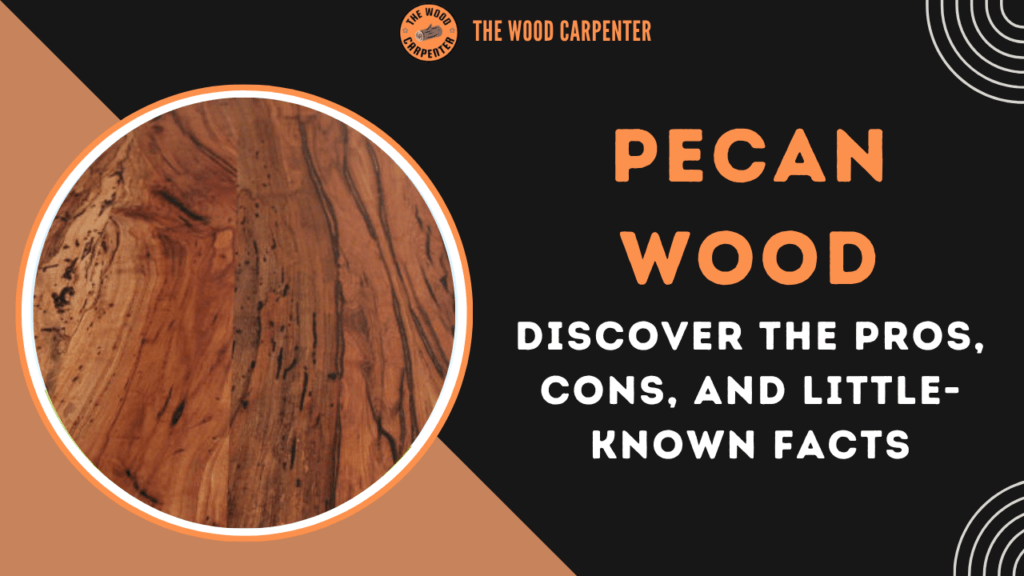
Pecan wood comes from the pecan tree (Carya illinoinensis), which grows in the southern parts of the United States and parts of Mexico. Most people know the pecan tree for its tasty nuts, but its wood is also very useful. It’s strong, long-lasting, and looks beautiful, making it a great choice for furniture, flooring, and other woodworking projects.
This guide explains the main features, benefits, uses and the main challenges of working with the pecan wood.
Characteristics of Pecan Wood
Color and Appearance:
The center part of pecan wood (called the heartwood) is light to medium brown with a reddish tint. The outer part which is called as the sapwood is lighter, usually yellowish-brown.
This color contrast gives the wood a unique and attractive look. The grain (the pattern of lines in the wood) is usually straight but can sometimes be wavy. It has a rough feel and a soft, natural shine.
Hardness and Strength:
Pecan wood is one of the hardest and toughest woods which is found in the U.S. It has a Janka hardness rating of about 1,820, which is similar to that of hickory wood.
It is very strong, stiff, and can handle heavy impacts. This makes it great for things that need to be extra durable, like floors or tool handles.
Workability:
Because it’s so hard, pecan wood can be tough to cut or shape. It quickly dulls cutting tools, so you need very sharp or special tools to work with it. It can also split if you don’t drill holes before nailing or screwing.
But the good news is that it sands, stains, and finishes really well. With some care, it can look amazing in the end.
Durability and Resistance:
Pecan wood lasts a decent amount of time, but it’s not the most durable when it comes to resisting decay (rot). It’s only somewhat resistant to insects like termites, and the heartwood (the inner part) can break down if not treated. However, it burns very well, so it’s also used as firewood or for cooking because it gives off good heat.
Common Uses of Pecan Wood
1. Furniture Making
Pecan wood is great for making furniture because it’s very hard and has a beautiful grain pattern. It’s commonly used for making dining chairs, tables, cabinets, and bedroom furniture.
It takes stain well, so you can give it different looks and finishes. Its strength means the furniture will last for many years—sometimes even passed down through generations.
2. Flooring
Because pecan is so tough and durable, it is perfect for the hardwood floors. It handles daily wear and tear very well. The natural color changes and grain designs give floors a unique and rich look.
It doesn’t expand or shrink as much as some other woods, making it more stable. Although it costs more than oak or hickory, many people choose it for its long life and beauty.
3. Tool Handles and Ladder Rungs
Pecan wood is strong and can handle shocks, which makes it perfect for tool handles and ladder rungs. It doesn’t crack easily under pressure or repeated use. That’s why it’s often used for handles on hammers, axes, chisels, and for sturdy ladder parts.
4. Veneers and Decorative Items
The lovely grain patterns in pecan make it ideal for thin layers of wood (called veneers) used on furniture, cabinets, and wall panels. Special pieces of pecan wood with swirling grain (called burls) are especially valuable for decoration. While pecan is too hard for detailed hand carving, it works well with machines and lathes. It can be shaped into bowls, spindles, and other turned items.
5. Firewood and Cooking
Pecan wood makes great firewood. It burns hot, lasts a long time, and gives off a pleasant, slightly sweet smell. It produces around 28 million BTUs of heat per cord. It’s also popular for barbecuing and smoking the meat, as it gives food a delicious and smoky flavor.
Advantages of Pecan Wood
Strength and Durability: Pecan is tough and resistant to wear, making it suitable for heavy-use applications.
Beautiful Grain: Its straight to wavy grain and warm brown tones add aesthetic appeal.
Versatility: Used in furniture, flooring, tool handles, veneers, and firewood.
Good Finishing Qualities: Takes stains and finishes well, allowing for a range of looks.
Pest Resistance: Naturally resistant to termites and some other pests.
Sustainable: Often harvested as a byproduct of nut farming, making it an eco-friendly option.
Disadvantages and Considerations
Workability: Its hardness blunts tools quickly and can cause tearout, requiring sharp blades and careful machining.
Weight: Pecan is a dense wood, making finished products heavier than those made from softer woods.
Availability: Pecan wood is less widely available than common hardwoods like oak or maple, especially outside the southern U.S.
Durability: While moderately durable, it is susceptible to decay and insect attack if not properly treated.
Seasoning: Pecan can be prone to warping, splitting, and checking during drying, so proper seasoning is essential.
Also read:
Lignum Vitae: Nature’s Hardest Wood – Care & Uses
Hickory Wood: Everything You Need to Know
How to Take Care of Pecan Wood
Taking care of pecan wood is not hard. Just follow these simple tips to keep it looking good and lasting long:
Clean Often:
Dust and dirt can build up on pecan wood. Wipe it gently with a soft cloth or a dust mop. This helps keep the surface clean without scratching it.
Polish Now and Then:
Use a wood polish or wax sometimes. This keeps the wood shiny and gives it extra protection from daily wear.
Keep it Dry:
Even though pecan wood is strong, too much water can damage it. Clean up any spills right away. Try not to put pecan furniture in damp places like bathrooms or basements.
Avoid Big Temperature Changes:
Wood can crack or bend if it gets too hot or too cold suddenly. Keep pecan wood furniture in rooms where the temperature stays steady.
How Pecan Wood Compares to Other Woods
Pecan vs. Hickory:
Pecan and hickory are from the same tree family. They are both strong and tough. But pecan is usually lighter in color and a little easier to cut and shape than hickory, which is harder and heavier. Pecan is also gentler on your tools.
Pecan vs. Oak:
Oak is a popular wood for furniture and floors. It has a classic look. Pecan has a richer color and more unique grain patterns. Both are strong, but pecan is a little softer, which makes it easier to work with.
Is Pecan Wood Expensive?
Pecan wood is not the cheapest, but it’s also not the most expensive. It costs more than softwoods like pine, but less than fancy hardwoods like walnut or mahogany. Because it’s strong, pretty, and useful for many things, pecan wood is a good deal for the price.
Frequently Asked Questions (FAQ)
Q1: Is pecan wood good for cutting boards?
Yes, pecan is a strong hardwood and works well for cutting boards. It can handle regular use, but because it’s so hard, it might dull your knives a bit faster than softer woods. To keep it in good shape, clean and care for it properly.
Q2: How long does pecan wood take to dry (season)?
Pecan wood usually needs 6 months to 1 year to dry completely, depending on the weather and how it’s stored. It can be dried naturally (air-dried) or in a kiln. Drying it too quickly or in the wrong conditions can cause it to crack or warp.
Q3: Can pecan wood be used outside?
Pecan wood can be used outdoors, but only if it’s properly treated and sealed. It’s not naturally resistant to rot or insects, so untreated wood won’t last long outside. It’s generally better for indoor use.
Q4: Does pecan wood have a smell?
Pecan wood doesn’t have much of a smell when you’re cutting or working with it. But when you burn it, it gives off a pleasant, slightly sweet aroma, which is great for cooking and heating.
Q5: How is pecan wood different from hickory?
Pecan and hickory are very similar—they’re from the same tree family and both are strong and hard. Hickory is usually a little denser and harder, but pecan is slightly easier to work with. Both are used for things like furniture and tool handles.
Final Thoughts
Its rich color, toughness & smooth finish makes it popular among the woodworkers and furniture makers. While it can be a bit hard to work with and may not always be easy to find, it’s still a great choice for making furniture, flooring, tool handles, and even firewood.
With proper care, pecan wood can last a long time and stay looking good, making it a smart and valuable option for many projects.

